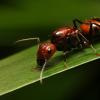Caught this queen yesterday in a pine forest in Nevada, she is about 4mm long, seems to be a species of pheidole. Thanks.
- Formiculture.com
- Forums
- Gallery
- Members
- Member Map
- Chat

Caught this queen yesterday in a pine forest in Nevada, she is about 4mm long, seems to be a species of pheidole. Thanks.
Temnothorax Cf. Nevadensis
What i am keeping Brachymyrmex patagonicus 1 worker x5 tetramorium immigrans 10 workers x2 lasius crypticus 5 workers Pheidole californica 6 queens150~ workers 10-30 majors, Formica argentea 10~ W
What I've kept crematogaster sp pheidole californica camponotus vicinus high elev, dumetorum,laevigatus, prenolepis imparis, pogonomyrmex californicus and subnitidus and californicus, veromessor andrei, camponotus sayi, hypoponera opacior ,Liometopum occidentale solnopsis molesta group, solenopsis xyloni.
It is quite possible it is that species, however, the tricarinatus group is a tad difficult to ID, so I think tricarinatus group is the furthest you can go without workers.
Hi there! I went on a 6 month or so hiatus, in part due, and in part cause of the death of my colonies.
However, I went back to the Sierras, and restarted my collection, which is now as follows:
Aphaenogaster uinta, Camponotus vicinus, Camponotus modoc, Formica cf. aserva, Formica cf. micropthalma, Formica cf. manni, Formica subpolita, Formica cf. subaenescens, Lasius americanus, Manica invidia, Pogonomyrmex salinus, Pogonomyrmex sp. 1, Solenopsis validiuscula, & Solenopsis sp. 3 (new Sierra variant).
It is quite possible it is that species, however, the tricarinatus group is a tad difficult to ID, so I think tricarinatus group is the furthest you can go without workers.
I guess, i used to have a colony of them and their queens looked identical from old picture on my phone
What i am keeping Brachymyrmex patagonicus 1 worker x5 tetramorium immigrans 10 workers x2 lasius crypticus 5 workers Pheidole californica 6 queens150~ workers 10-30 majors, Formica argentea 10~ W
What I've kept crematogaster sp pheidole californica camponotus vicinus high elev, dumetorum,laevigatus, prenolepis imparis, pogonomyrmex californicus and subnitidus and californicus, veromessor andrei, camponotus sayi, hypoponera opacior ,Liometopum occidentale solnopsis molesta group, solenopsis xyloni.
 |
Ants & Myrmecology →
General →
Ant Misinformation - Competent People WantedStarted by The_Gaming-gate , Mar 27 2024 |
|

|
|
Anting →
General Anting →
Queen ant!Started by cooIboyJ , Mar 6 2024 |
|

|
||
 |
Ant Keeping →
Ant Keeping Journals →
My C. chromaiodes JournalStarted by Artisan_Ants , Mar 3 2024 |
|

|
|
Ant Keeping →
General Ant Keeping →
Do Solonopsis molesta Need Diapause?Started by Artisan_Ants , Feb 16 2024 |
|

|
||
Anting →
Ant ID Requests →
Got a new queenStarted by AntidepressAnt , Feb 10 2024 |
|

|
0 members, 0 guests, 0 anonymous users